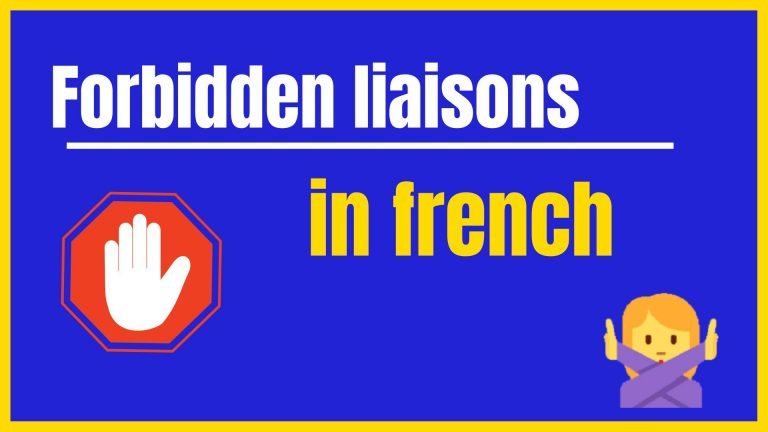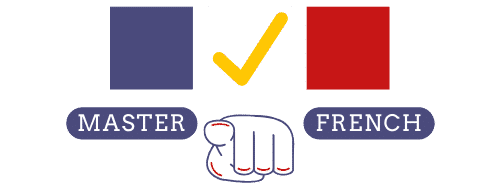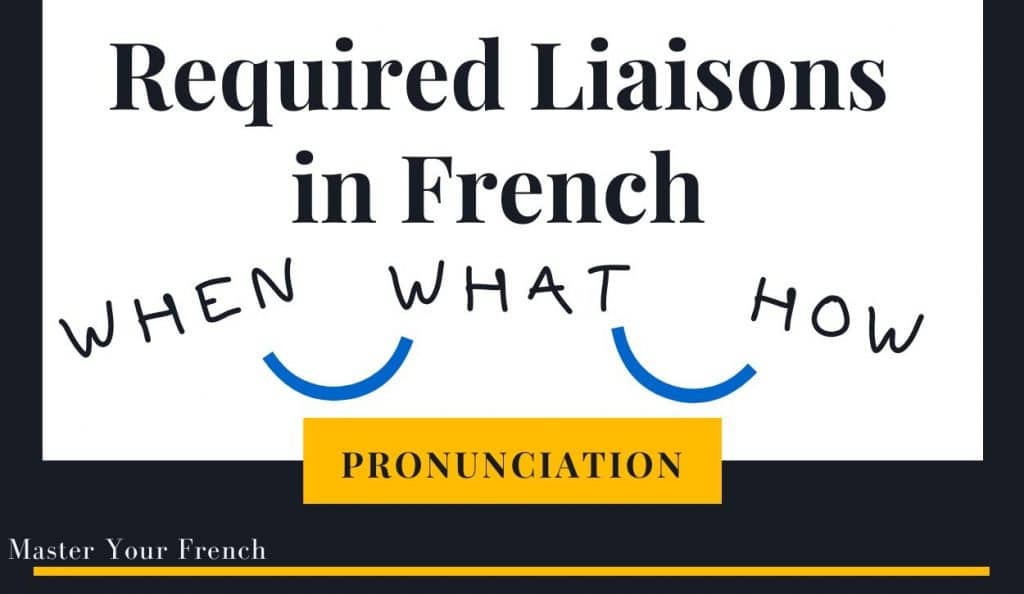Forbidden liaisons in the French language: rules + examples
Updated: 7 August, 2023 by Mylene in Pronunciation Lessons ▪

What is a forbidden liaison in french?
A liaison is the pronunciation in one syllable of the final consonant of a word, normally unpronounced, with the initial vowel of the following word. There are many situations where the connection is never made. Therefore, we say that it is prohibited. Linking is not allowed when:
- There is a pause between 2 words,
- There is a punctuation mark between 2 words,
- The function of the word prohibits it.
The 11 most frequent cases are presented in the following:
- after a singular noun
- between a nominal group and a verb
- between a subject nominal group and another group
- after the pronoun of an inverse verb
- after the pronouns un and aucun
- after the digit un
- after quelqu’un
- after interrogative adverbs
- before an aspirated h
- after et
- after cent
Watch this video to find out the main forbidden liaisons in french
Rules and examples
1. After a singular Noun
- un bien // immobilier [ɛ̃.bjɛ̃.imɔbilje] a property
- un enfant // adorable [ɛ̃.nɑ̃fɑ̃.adɔʁabl] a lovely child
- l’étudiant // est arrivé [letydjɑ̃.ɛ.taʁive] the student has arrived
Liaison can only occur after a normally silent consonant at the end of a word. If the consonant is not silent at the end of the word, then you can perform a sequence with the preceding vowel. To find out if a consonant is silent or not at the end of a word, you can consult the guide to silent letters in the blog.
Exceptions : set phrases
A set phrases is a group of words that have a meaning together. You cannot separate the words or add another word; otherwise the meaning will be changed.
For example :
- un pied-à-terre [ɛ̃.pje.ta.tɛʁ] a pied-à-terre
- un pot-au-feu [ɛ̃.po.to.fø] a pot-au-feu
2. Between the noun phrases subject and the verb
- les voisins // ont appelé [le.vwazɛ̃.ɔ̃.taple] the neighbors called
- le chien aboie [lə.ʃjɛ̃.abwa] the dog barks
- le crayon est bleu [lə.krejɔ̃.ɛ.blø] the pencil is blue
3. Between a subject nominal group and another group
- des voisins avec des enfants [de.vwazɛ̃.avɛk.de.zɑ̃fɑ̃] neighbors with children
- des crayons et des stylos [de.krejɔ̃.e.de.stilo] pencils and pens
4. After the pronoun of an inverse verb (The pronoun is part of the verb group)
- Ont-elles // appelé ? [ɔ̃.tɛl.aple] Did she call?
- A-t-on // essayé ? [a.tɔ̃.eseje] Have we tried?
5. After un and aucun as pronoun
- j’en ai un // aussi [ʒɑ̃.ne.ɛ̃.osi] I have one too
- j’en ai aucun // à Paris [ʒɑ̃.ne.okɛ̃.a.paʁi] I have none in Paris
6. After un as digit « 1 »
- un // et un // égalent deux (1+1=2) [ɛ̃.e.ɛ̃.egal.dø] one and one equal two
7. After quelqu’un
- Quelqu’un // a téléphoné. [kɛlkɛ̃.a.telefɔne] someone called?
- Quelqu’un // a-t-il quelque chose à dire ? [kɛlkɛ̃.a.til.kɛlkə.ʃoz.a.diʁ] someone has something to say?
8. After adverbs in a question
- Quand // est-il arrivé ? [kɑ̃.ɛ.til.aʁive] when he arrived?
- Comment // accepter ? [kɔmɑ̃.aksɛpte] how to accept?
- Combien // en veux-tu ? [kɔ̃bjɛ̃.ɑ̃.vø.ty] how many do you want?
Exception
These two exceptions are set phrases:
- Comment allez-vous ? [komɑ̃talevu] how are you?
- Quand est-ce que… [kɑ̃tɛskə] when
9. Before an aspirated H
There are 2 kinds of H. The liaison is forbidden before the aspirated H.
- des // haricots, [de.aʁiko] beans
- des // haches, [de.aʃ] axes
- en // haut, [ɑ̃.o] at the top
You have to pronounce the liaison before the mute H:
- vous habitez [vu.zabite] you lived
- des héroïnes [de.zeʁoin] heroines
10. After et
- un homme et // une femme [ɛ̃.nɔm.e.yn.fam] a man and a woman
- un chien et // un chat [ɛ̃.ʃjɛ̃.e.ɛ̃.ʃa] a dog and a cat
11. After cent when followed by another numeral
- cent // un [sɑ̃.ɛ̃] hundred and one
- cent // onze [sɑ̃.ɔ̃z] hundred and eleven
- trois-cent // un [tʁwa.sɑ̃.ɛ̃] three hundred and one
The liaison is forbidden after the numeral “cent”, but ou should pronounce the “enchainement” with the following nasal vowel. You hate to practice the pronunciation of “enchainement” to have a better melody.
Test your knowledge
You can test knowledge by joining the online course. Hundreds of quizzes are waiting for you!



pourquoi quelque fois on prononce “une” comme iun et autres comme un? merci
Bonjour, le mot “une” se prononce toujours /yn/. Il ne faut pas prononcer de voyelle nasale. Cordialement, Mylène